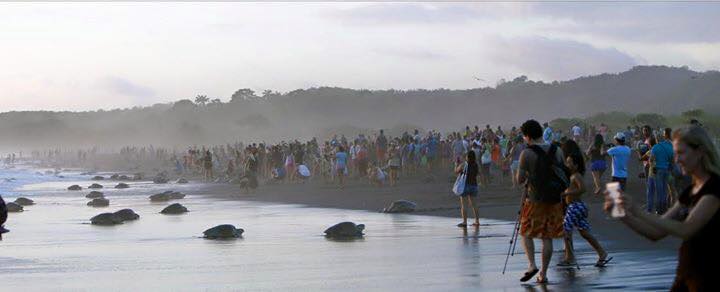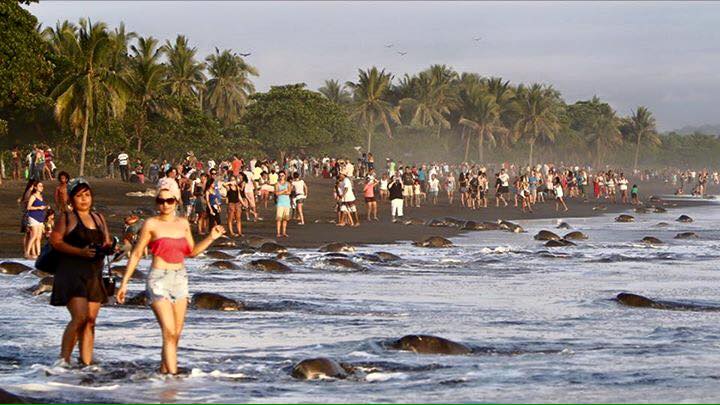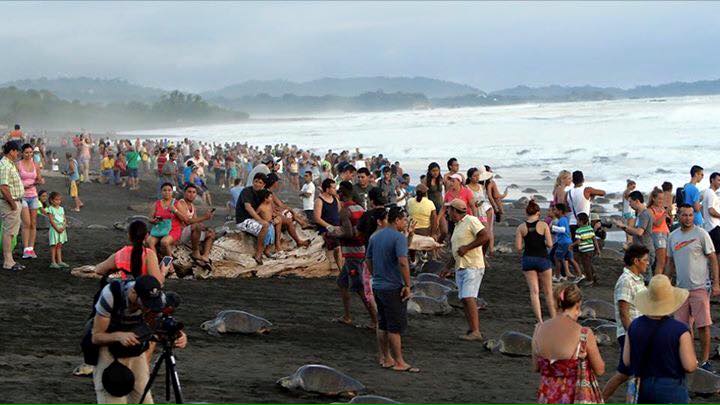It’s not easy being a sea turtle. The odds are against you from the start. Lots of creatures like to eat the eggs, and then the hatchlings have to make their way to the sea while avoiding crabs and birds. Even beach lighting can confuse their direction. Only about one in a hundred eggs will actually make it to an age of reproduction.
Then, as an adult, they have to worry about getting entangled in fishing nets or consuming plastic debris, or having someone cut off their flippers for soup or turning the shell into a tourist trinket. And for females, the egg laying is always a risky venture. The female turtle will return to the beach of her birth, which will hopefully still be accessible. She is very vulnerable as she lumbers up the beach to escape the high water line that might flood her nest.
The Kemp’s and olive ridleys are the only turtle species to exhibit the unusual nesting practice known as arribada, or arrival, when hundreds or thousands of females gather en masse and descend on a beach area. The turtles are solitary creatures until the females gather off shore and then collectively swarm the beach. It was during one of these mass arribadas, when hundreds of egg-laying turtles converged on the Costa Rican beach of the Ostional Wildlife Refuge, that the turtles were mobbed by unruly humans. The selfish selfie-takers trampled nests and even placed their youngsters to ride on the turtles’ backs. The giggling gaggle of inhumane humans had no awe at all for the wondrous event unfolding around them nor awareness of the privilege that it is to witness the labor of these magnificent creatures as they perform their ancient egg-laying ritual.
Their nesting beach is usually inaccessible to the masses, but recent weather conditions left it exposed. In light of this latest spectacle, the park has instituted new procedures to limit the number of tourists to 10 per group with a 30-minute time limit during the nesting period.
The olive ridley is more abundant than most sea turtle species, but it is still considered endangered in the U.S., as its populations are in decline. It is a relatively small turtle of about two feet in length and weighs under a hundred pounds.
I’ve had the great privilege of seeing nesting turtles make their way up the beach in Panama to lay their eggs on a moonlit night. Since the eggs have so many predators that want to eat them (humans, raccoons, dogs) we collected the nests and reburied them in a protected area. The greatest thrill of all is when the nests erupt and tiny baby turtles scramble to the surface, anxious to make their way to the sea before they are eaten by crabs or birds.
I’m sure you are not one of THOSE tourists who would be so disrespectful of wildlife as to interfere with nesting. Maybe you are even conservation minded and would like to participate in sea turtle preservation projects. There are many groups throughout the Americas that offer citizen patrols to identify nests and secure them from predators. It is a wonderful educational experience for youngsters. But, also learn about the obstacles mature turtles face at sea such as plastics in the ocean, improper fishing nets, and oil spills.
Sea turtles have been around since the time of dinosaurs, about 110 million years. They are one of Earth’s oldest creatures. Yet, all species are considered either threatened or endangered of becoming extinct. We should all care about that.









